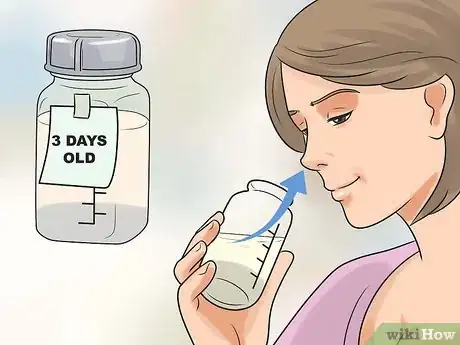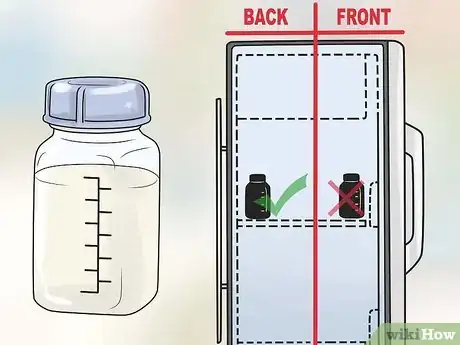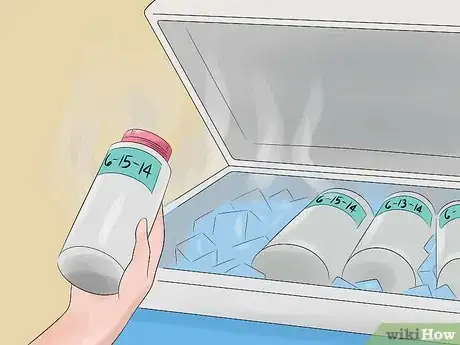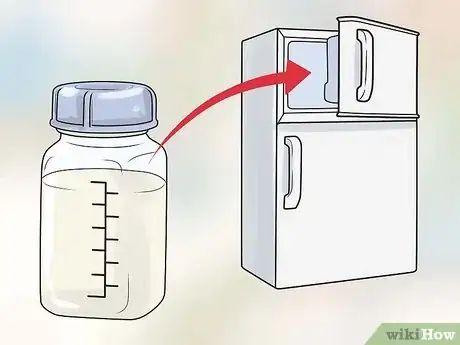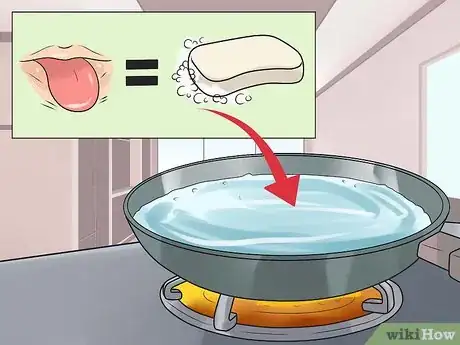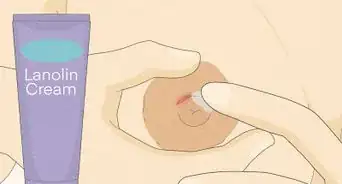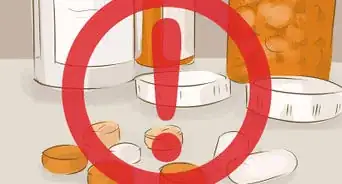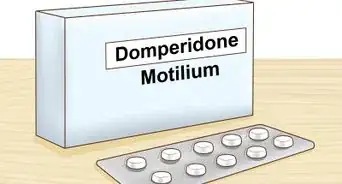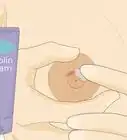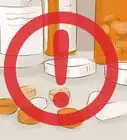This article was co-authored by Carrie Noriega, MD. Dr. Noriega is a Board Certified Obstetrician & Gynecologist and medical writer in Colorado. She specializes in women’s health, rheumatology, pulmonology, infectious disease, and gastroenterology. She received her MD from the Creighton School of Medicine in Omaha, Nebraska and completed her residency at the University of Missouri - Kansas City in 2005.
wikiHow marks an article as reader-approved once it receives enough positive feedback. In this case, 80% of readers who voted found the article helpful, earning it our reader-approved status.
This article has been viewed 412,089 times.
Some moms like or need to express breast milk so that their baby can be fed when they're not around. It is important for your baby’s health that this milk does not go rancid. There are a variety of ways to ensure that it keeps. Luckily, verifying that it is fresh should be a simple and largely familiar process.
Steps
Testing for Spoilage
-
1Don’t be afraid of odd colors and textures. It is common for the color and the texture of your milk to change. Much of this reflects the changing dietary needs of your baby. Appearance is no way to judge the freshness of milk .[1]
- It is common for the color of milk to change during the course of storage or even a single feeding. It is natural for the milk to occasionally have a bluish, greenish, yellowish, or even brownish color.
- It is also common for it to separate into layer of lighter milk and more dense cream. This is not dangerous, but you should gently swirl it to mix the two together.
-
2Be careful with milk that is three days old. Expressed milk can often last much longer than this, but its shelf life varies considerably depending upon the details of its storage. After three days in the refrigerator, you should smell the milk carefully to verify that it is fresh.[2]
- Similarly, you should be careful if the milk has been out for three hours without being refrigerated.[3]
- It is okay to store milk at room temperature from three to six hours depending on how cool the room is. If you are storing milk in an insulated cooler, it is safe to leave it in the cooler for 24 hours.
Advertisement -
3Test for sour smell. Sour breast milk has the same strong, distinctive smell that sour cow milk has. This is the one and only meaningful way to determine if milk is rancid.
-
4Don’t fret over a metallic or soapy smell. Some mothers will find that their milk will over time develop a soap like or metallic taste if stored. This taste is not a sign of spoilage and most babies do not mind it.
- If your baby does reject it, try scalding it before storing to halt the development of this smell.
Preventing Spoilage
-
1Store in the back of the fringe. Keeping the milk on or near the door will expose it to more heat or temperature fluctuations from the opening and closing of the refrigerator. In the back the milk will be colder and more likely to keep.[4]
-
2Store in a tightly sealed container. Glass, disposable bottle liners, or “mother’s milk” bags are best. Polypropylene or polybutylene hard plastics are preferable to soft plastic polyethylene bags.
- It is also important to ensure that other containers in the fridge are closed tightly so that that the milk does not absorb these other odors.
- A box of baking soda in the refrigerator can help absorb other smells.[5]
-
3Date containers of milk. Writing the date you expressed the milk on the container can help you make sure you use the older milk first and before it spoils. You can label each container or put all milk from the same week or month together in a bag or box that is labeled.
-
4Freeze the milk. If you do not plan to use the milk in five to eight days, you should freeze it. Place it in a tightly sealed container in the back of the freezer. Use within 24 hours after thawing.[6]
- Depending upon how frequently you open the freezer, your milk can last for anywhere from three months to a year.[7]
- Do not use a microwave to thaw the milk. Thaw it under warm, running water. Do not bring to boil.
- It is natural for it to separate into milk and cream while frozen. Swirl it gently to mix these together.[8]
-
5Scald milk with a soapy flavor, if your baby won't drink it. If you find that your milk has a soapy flavor and that this is a problem for your baby, you can try scalding it. Heat to about 180 °F (82.2 °C) (it should show signs of a full bubble, but not a rolling boil). Immediately afterward cool and store the milk.
- If this flavor does not bother your child, do not scald it. The milk will lose some of its nutrients in the process.[9]
Expert Q&A
Did you know you can get expert answers for this article?
Unlock expert answers by supporting wikiHow
-
QuestionWhy is my 7th month baby not drinking my expressed breast milk?
 Carrie Noriega, MDDr. Noriega is a Board Certified Obstetrician & Gynecologist and medical writer in Colorado. She specializes in women’s health, rheumatology, pulmonology, infectious disease, and gastroenterology. She received her MD from the Creighton School of Medicine in Omaha, Nebraska and completed her residency at the University of Missouri - Kansas City in 2005.
Carrie Noriega, MDDr. Noriega is a Board Certified Obstetrician & Gynecologist and medical writer in Colorado. She specializes in women’s health, rheumatology, pulmonology, infectious disease, and gastroenterology. She received her MD from the Creighton School of Medicine in Omaha, Nebraska and completed her residency at the University of Missouri - Kansas City in 2005.
Board Certified Obstetrician & Gynecologist This is difficult to answer exactly, but it may be the milk is spoiled or it somehow tastes different from the milk coming from the breast, especially if the milk was pumped long ago. Try giving the baby milk that was pumped that day to to see if they will drink this. If they do, then the older milk may be bad and you need to discard it. If they don’t, then the baby may be ill. Check to see if they are taking milk from the breast or look for signs of dehydration or hunger. These signs may be crying or fussiness even though they just fed, no wet diapers, dry lips. If there are signs they are not drinking then see your pediatrician.
This is difficult to answer exactly, but it may be the milk is spoiled or it somehow tastes different from the milk coming from the breast, especially if the milk was pumped long ago. Try giving the baby milk that was pumped that day to to see if they will drink this. If they do, then the older milk may be bad and you need to discard it. If they don’t, then the baby may be ill. Check to see if they are taking milk from the breast or look for signs of dehydration or hunger. These signs may be crying or fussiness even though they just fed, no wet diapers, dry lips. If there are signs they are not drinking then see your pediatrician.
Warnings
- If you are sick or on medication and breastfeeding, talk to your doctor for advice on the suitability of storing pumped milk.⧼thumbs_response⧽
References
- ↑ http://www.breastfeedingbasics.com/qa/color-breast-milk
- ↑ http://www.workandpump.com/storage.htm
- ↑ http://www.babycenter.com/404_how-long-does-breast-milk-stay-fresh_8918.bc
- ↑ http://www.workandpump.com/storage.htm
- ↑ http://kellymom.com/bf/pumpingmoms/milkstorage/lipase-expressedmilk/
- ↑ http://kellymom.com/bf/pumpingmoms/milkstorage/lipase-expressedmilk/
- ↑ http://www.babycenter.com/404_how-long-does-breast-milk-stay-fresh_8918.bc
- ↑ http://www.workandpump.com/storage.htm
- ↑ http://kellymom.com/bf/pumpingmoms/milkstorage/lipase-expressedmilk/
About This Article
Expressed breast milk usually lasts 3 hours unrefrigerated or up to 3 days in the refrigerator. To know if it has spoiled, smell it to see if there’s a sour smell, in which case you shouldn’t use it. Don’t be alarmed if the color of the milk changes, or if it separates, as this is normal and doesn’t necessarily mean it’s gone bad. If the milk smells fine, but you’re unsure if it’s good, scald it in a pan by heating it to a full bubble, but not a rolling boil, to kill any bacteria. Then, cool it before giving it to your baby. To learn how to prevent milk spoilage, read more from our Obstetrician co-author!

